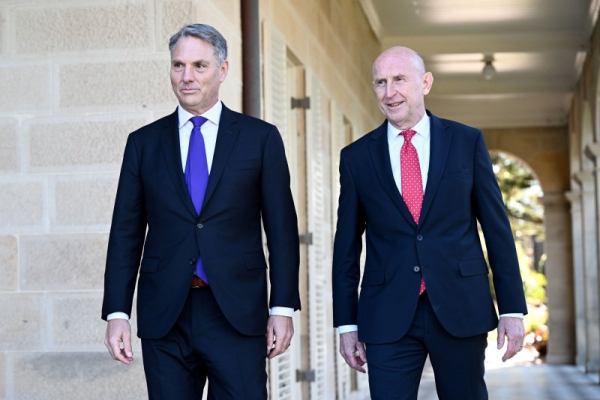

Australian Defense Secretary Richard Marles (L) and British Defense Secretary John Healey arrive at Admiralty House in Sydney on Friday ahead of unveiling a multi-billion dollar deal to build nuclear-powered submarines for Australia in Australia. Photo by Dan Himbrechts/EPA
Britain and Australia confirmed Friday that they would proceed with a $245 billion nuclear-powered submarine deal as part of a defense pact between the two countries and the United States — despite Washington rethinking its involvement.
Following a meeting, Australian Defense Secretary Richard Marles said he and British Defense Secretary John Healey would sign a 50-year cooperation treaty on Saturday to deliver an Australian fleet of submarines, powered by British nuclear reactors.
Marles hailed the deal, part of a trilateral security pact signed in 2021, as the most significant U.K.-Australian treaty signed in the 124-year history of modern Australia.
The AUKUS alliance, aimed at countering China’s military rise in the Asia-Pacific, called for Australia to be armed with eight nuclear submarines, three repurposed from the United States’ existing fleet and the remainder a new SSN-AUKUS submarine that Australia and Britain would build together.
However, concerns were raised that the first U.S. submarines wouldn’t be handed to Australia within the timeline of the early 2030s because U.S. Defense Secretary Pete Hegseth is reviewing the Biden administration-brokered AUKUS and the U.S. submarine pipeline was behind time.
Healey said they welcomed Hegseth’s review as a chance for the new administration of U.S. President Donald Trump to “renew their commitment,” which he said he fully expected to happen.
Marles said last month that he was “very confident” the United States would remain in AUKUS because of its strategic benefit to all three countries.
The pact came into force three days before Trump was sworn in as the 47th president of the United States in January, triggering a review to ensure it is a fit with his “America First” policy.
In a meeting in Singapore in June, Hegseth told Marles that Australia should increase defense spending to 3.5% of GDP.
Elbridge Colby, the U.S. defense official carrying out Hegseth’s review, has said AUKUS could compromise national security if the United States were to begin selling its Virginia-class submarines to Australia in the early 2030s, as per the original agreement.
Neither Healey nor Marles would say whether the two countries would go it alone with building the submarines if the United States opted to withdraw.
The Australia-U.K. treaty encompasses a comprehensive framework to develop the necessary infrastructure and workforce in Australia to build, operate and support the submarine program, with the deal providing a boost to British exports of more than $26 billion by 2050.
“Through the treaty, we are supporting high-skilled, well-paid jobs for tens of thousands of people in both the U.K. and Australia,” said Healey.
Australian Strategic Policy Institute senior analyst Euan Graham said the new treaty was not sending a message to the Trump administration but was “more of a reflection that AUKUS has always been a 3-way arrangement, and that the U.K.-Australia side of the triangle is vital to its success.”
He said the program would also produce economies of scale, allowing Britain’s Royal Navy to increase its nuclear fleet from seven to 12 submarines.